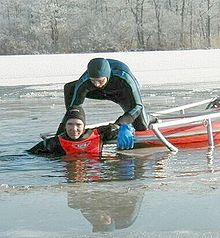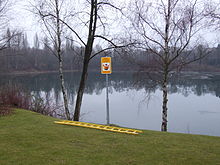Ice rescue

As ice rescue is called the saving of collapse in the ice people by forces of the water rescue or passers-by.
causes
Especially on beautiful winter days, ice rescue is very important to the water rescue organizations , as many walkers, athletes and children spend time on unapproved ice surfaces. Insufficient load-bearing capacity, thermal radiation or deceptive ice thickness combined with carelessness and overconfidence, people break in quickly. Most of them cannot free themselves and they are quickly threatened with death due to hypothermia . In flowing water there is also the risk of drowning if the person who has broken in gets under the ice surface, is transported by the current and can no longer find the entry hole.
Passers-by often stand around idly due to fear or ignorance, so that stationary water rescue stations , ice guards and rapid water rescue teams are often the only rescue for the casualties.
Rescue equipment

All objects that distribute the weight of the rescuer and the casualty on the ice as large as possible and can bridge the distance to the casualty are suitable as rescue equipment for ice rescue. These can be poles, ladders and boards, for example. Trained water rescuers often have special equipment with which they can provide help more effectively.
Light water rescue devices are often available at smaller stations. They are available as fully assembled fixed devices, inflatable, single-hulled or in a catamaran version. The advantages of these devices are that they are easy to transport and no trailer is necessary for transport. Since only one person is required to operate, light water rescue devices are quick and easy to use. The disadvantage is that the rescuer has to put on a survival suit or dry suit, as the devices are not fully buoyant. Another point is the limited capacity of the device to a maximum of one person to be rescued.
The stationary ice rescue devices , usually consisting of welded aluminum tubs or a boat with runners, are characterized by a high load-bearing capacity. The advantage is that the rescuer does not come into direct contact with the water and thus a high level of self-protection for the rescuer is guaranteed. On the other hand, there are the disadvantages that stationary ice rescue devices are usually very large, heavy and unwieldy. That is why their use is only possible in stations located directly on the water, where sufficient helpers are available to operate the device.
Action
Use with ice rescue device
Due to the risk of rapid hypothermia in ice water, an ice rescue mission is always time-critical. The rescuers put on survival suits on the way to the scene of the accident . When they arrive at the scene of the accident, the situation is first investigated by determining the distance to the bank, the bearing capacity of the ice and the number of people who broke in. Should it be necessary, the rescuers will request additional forces. The ambulance service and emergency doctor must always be notified.
When the actual rescue operation begins, the most important thing is to secure the rescuer and the reserve with lines on the bank or on firm ice. The rescuers must make sure that they do not form groups to prevent another break-in. For protection, all rescuers should wear life jackets, if available.
The rescuer with the rescue equipment approaches the casualty. Once he has arrived, he tries to calm the casualty down and carefully pull him onto the ice rescue device without hectic. The casualty should be moved as little as possible ( rescue death ). Rescuers and casualties are withdrawn by the leash guide at the rescuer's signal. As soon as the casualty is safe, he or she must be brought into the slipstream or into a building as quickly as possible. If the casualty is still in the defense stage, the rescuers should remove their wet clothing, wrap them in blankets and provide first aid .
Rescue without special equipment
If there is an ice accident when there are no trained lifeguards or water rescuers nearby, an immediate rescue must be organized with all available helpers. In this case, the sending of the emergency call and the organization of the rescue equipment is carried out by less experienced people. The rescuer crawls carefully on his stomach with the tools to the break-in point. He hands the aids or throws them to the casualty and pulls him out. The problem can arise here that the victim is so exhausted that he can no longer hold on. Once the casualty has been rescued from the danger area, first aid must be provided again.
Human chain
If there are no aids at all, the last option is a human chain. This is formed by several helpers who lie down one behind the other on their stomach and hold onto the legs of the person in front. The lightest should be at the front end of the chain so that the ice at the break-in point is as little stressed as possible. He grabs the casualty and the whole chain pulls both back.
The human chain should be the last resort, as it harbors very great dangers even for experienced helpers:
- The helpers can break in
- Ice rescue and survival suits are usually not available
- The man behind can let go and break the chain
The rescuers can become casualties themselves very quickly.
Self-rescue
If there are no helpers around, the casualty must try to save himself from the ice, a distinction is made between two different cases.
With solid ice, the weight is distributed as much as possible on the ice in order to pull itself out. Then the casualty has to crawl back to the bank as flat as possible on his stomach.
If the ice is brittle, the casualty can try to break off the ice again and again in the direction of the bank and thus expand the break-in point to the bank.
Ice claws
If, despite the risks, you cannot do without walking on ice surfaces, you should consider carrying ice claws . These claws consist of two sturdy handles with a spike, which are carried around the neck on a cord and are ready to hand. You can use it to pinch yourself on the slippery ice and perhaps pull yourself out, but this requires good coordination and physical strength.
Individual evidence
- ↑ Wasserwacht Bergen.de: Special Edition Ice Rescue ( Memento of the original from March 4, 2016 in the Internet Archive ) Info: The archive link was inserted automatically and has not yet been checked. Please check the original and archive link according to the instructions and then remove this notice. , In: Der Seeräuber - The information magazine of the Bergen Water Rescue and the Bergen Rescue Association. V. , Issue 3, November 2006 (PDF 520kB)


